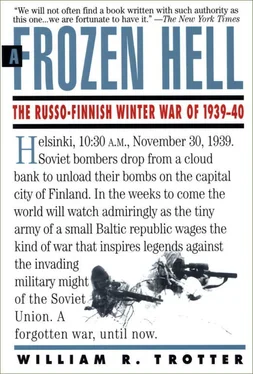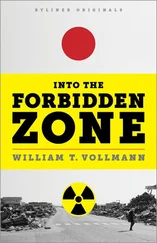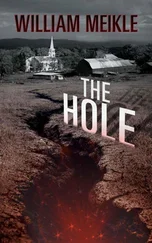Russian infantry units had about the same number of light mortars as their Finnish counterparts, but each infantry regiment could also call on support from batteries of powerful 120 mm. heavy mortars. Despite the Finns’ superior fire control and accuracy, their chronic ammunition shortage seldom allowed them the luxury of counterbattery or saturation fire. The Russians could afford to fire more shells of a single caliber, on a single day, than were contained in the entire Finnish reserves.
Finnish tank forces were operationally nonexistent. Antitank training had been attempted with some clattery old Renaults dating from 1918, but most Finnish soldiers had no realistic idea of what it was like to face modern panzers. Their first confrontations with Soviet armor would be traumatic.
The army’s first antitank guns, 37 mm. Bofors weapons from Sweden, were uncrated just weeks before the war broke out. Few of their crews had had time even to face a dummy tank in training before they were called on to fight large formations of the real thing. The total number of Bofors guns available was so small that they were parceled out two or three to a regiment. There had been long discussions about what sort of antitank weapons should be issued to the infantry at the platoon level. The weapons finally chosen, 20 mm. Lahti antitank rifles, did not in fact reach the troops in significant numbers until after the war was over.
Finnish small arms were at least as good as those found in the Red Army. The standard infantry rifle was one of several versions of the basic Russian Moisin/Nagant design, modified in some details by Finnish ordnance experts and of overall higher manufacturing quality than its Russian counterpart. This rifle fired a 7.62 mm. round; it was a sturdy, rugged, bolt-action piece noted for its accuracy. Although the basic Moisin action had been adopted by the Russians as far back as 1891, the design was so sound that some Soviet satellite armies could still be seen using it through the 1950s.
The Finns’ basic heavy machine gun was a water-cooled version of the classic Maxim gun from the Great War era. These were cumbersome and brutally heavy weapons, but they were rugged and dependable, even under severe winter conditions. The light machine gun—equivalent in its role to the American Browning Automatic Rifle of that day—was the 7.62 mm. Lahti/Saloranta, considered by firearms experts to be one of the first really practical “light” automatics to enter service after World War I. Indeed, photos of the weapon reveal a striking resemblance to many contemporary designs. It was a fairly heavy weapon for its day—twenty-three pounds with loaded magazine—but it could be fired from a bipod or from the shoulder, using either a twenty-round box magazine or a seventy-five-round drum. The Lahti was air cooled and recoil operated, and was one of the few automatics in service anywhere at that time that permitted its gunner to switch from single shot to full automatic. In the latter mode it had a cyclic fire rate of 500 rounds per minute. It was a powerful weapon, with a muzzle velocity of 2,625 feet per second, comparable to some of today’s streamlined assault rifles.
Originally, the Lahti had been designed as an export weapon, Finland’s entry into the international arms market. As far as can be determined, however, the only foreign army that purchased a significant number of them was, rather oddly, the Chinese. It was not, therefore, a weapon designed for specifically Finnish conditions. Its one weakness was a certain degree of over-manufacture in its moving parts, tolerances too fine and too numerous, so that it sometimes froze in severe cold, precisely the kind of weather it would be used in. When that happened, it was sometimes possible to reactivate a frozen Lahti by the simple expedient of urinating on it.
The most interesting weapon in the Finnish arsenal, however, was the famed “Suomi” submachine gun, or “machine pistol” (koonipistolit in Finnish). The Suomi was one of the least-known submachine gun designs of its day, but it was actually rather influential. So effective was it in the Winter War that the Soviets paid it the ultimate compliment of copying it for their famous PPSh “burp gun” design, which would be the mainstay of Communist Bloc armies until the advent of the AK-47.
The Suomi was a splendid weapon for the kind of small-unit, bushwhacking tactics the Finnish Army excelled in. A ski patrol deep in the forest, where encounters with the enemy were likely to be sudden, close-range affairs, didn’t need an accurate long-range rifle; what was needed was a meatchopper, and the Suomi filled the bill. It had half again as much muzzle velocity as a Tommy Gun (1,300 feet/second as opposed to 920) and spewed out its 9 mm. slugs at a sizzling rate of 800–900 rounds/minute. One area where it lost out against the Thompson or the German “Schmeisser” was appearance: in terms of its lines, the Suomi was as brutal looking as an ox.
Ruggedly designed, operating on the “blowback” principle, it was short enough to dangle conveniently from a skier’s shoulders and could be brought into action from that position in a split second. It also had a single-shot option for aimed fire, although it was not terribly accurate beyond 100 yards in that mode. Up close, however, it was lethal. The Russians feared and hated Suomi gunners, and with good reason—one Finnish soldier would be decorated for scoring over 200 confirmed kills with his Suomi during the motti battles in the central forests. The preferred method of ammo feed was a seventy-round drum; the caliber was 9 mm. Twenty- and fifty-round box magazines were also available for this weapon, but they do not seem to have been used as much in the Winter War as they would be during the later “Continuation War,” when a much higher percentage of Finnish soldiers were armed with rapid-fire weapons than was the case in 1939.
Because the Suomi burned ammo at a furious rate, only a few hundred of them were issued per division at the start of the war. Under combat conditions, of course, many men managed to “acquire” Suomis to replace their bolt-action rifles. In the beginning, though, only the coolest and most intelligent troopers were issued the gun; to be designated a Suomi gunner was an honor almost the equivalent of another stripe.
Interestingly, the Russians had a chance to look at the Suomi before the war and turned it down. As Marshal of Artillery Voronov tells it:
Way back in the beginning of the 1930s, we had acquired a model of the “Suomi” submachine gun. It was even tested by a commission of specialists on infantry weapons. The commission decided that it was a “police” weapon, unsuitable for military combat operations. The design and production of such submachine guns was considered superfluous. Acting on his own initiative, the Soviet designer V. G. Federov designed during those years a low-powered submachine gun which used Nagant revolver bullets. After being tested, this submachine gun was also rejected. Now, having encountered the widespread use of submachine guns in the Finnish Army, we bitterly regretted these miscalculations. [5] Bialer, 132.
Official Red Army doctrine in 1939, Voronov goes on to say, still emphasized massed volleys of rifle fire. It was feared that if the poorly educated recruits got hold of automatic weapons, they would waste too much ammo.
There was another weapon in the Finns’ arsenal, one that occasioned any number of colorful newspaper yarns, and that was the puukko knife, a Lapp blade about the size and heft of a Bowie knife. Most of the tales about single-handed Finns dispatching whole squads of Russians with their puukkos were obviously concocted by correspondents in the bars of the Helsinki hotels. The weapon did find employment from time to time in desperate situations, but the Finnish soldier no more went looking for hand-to-hand combat than did the average soldier in any army.
Читать дальше












